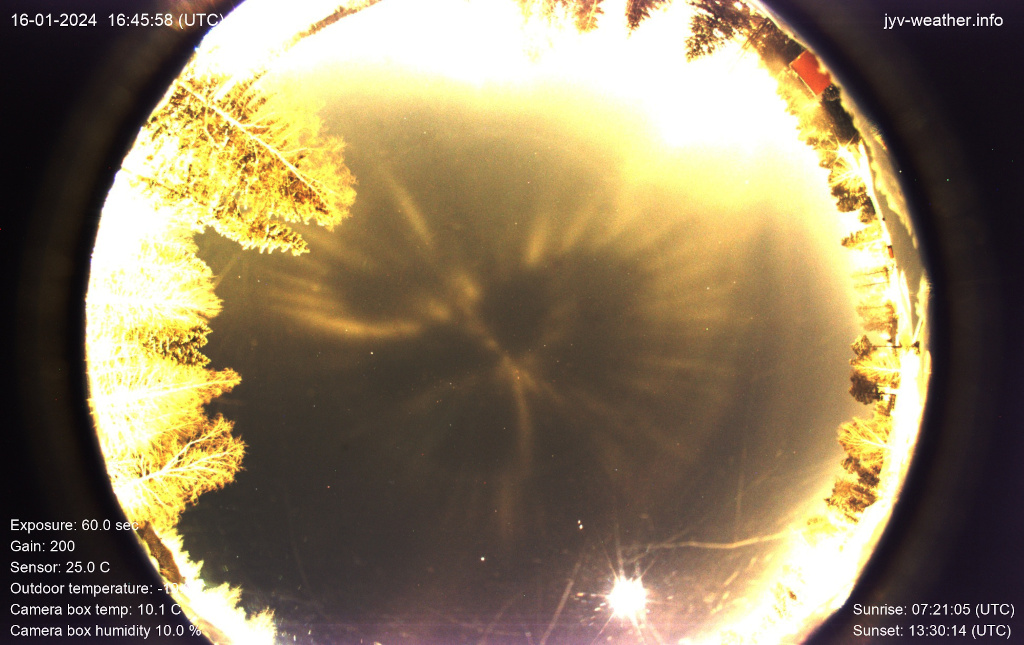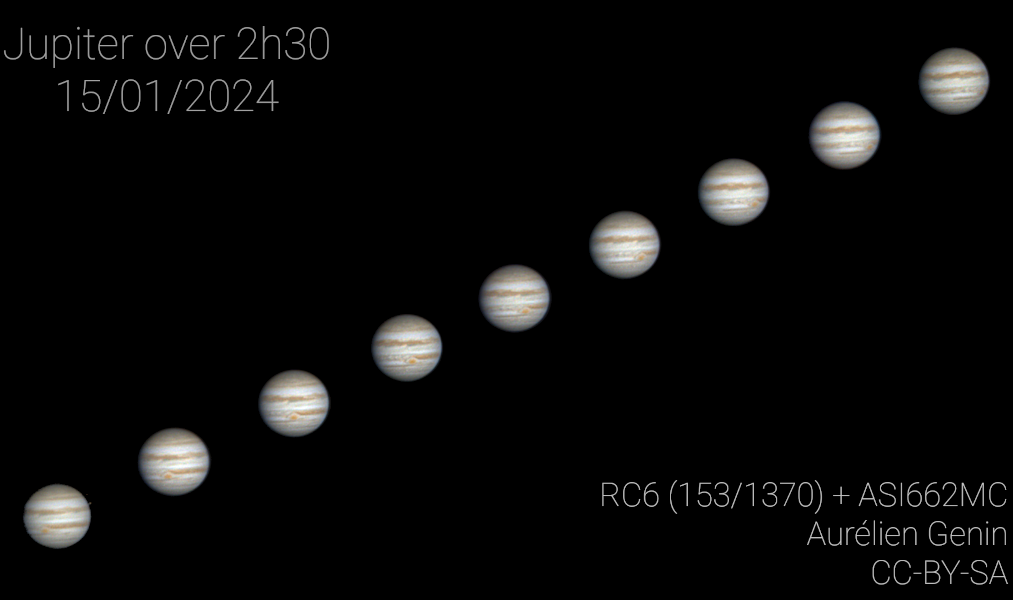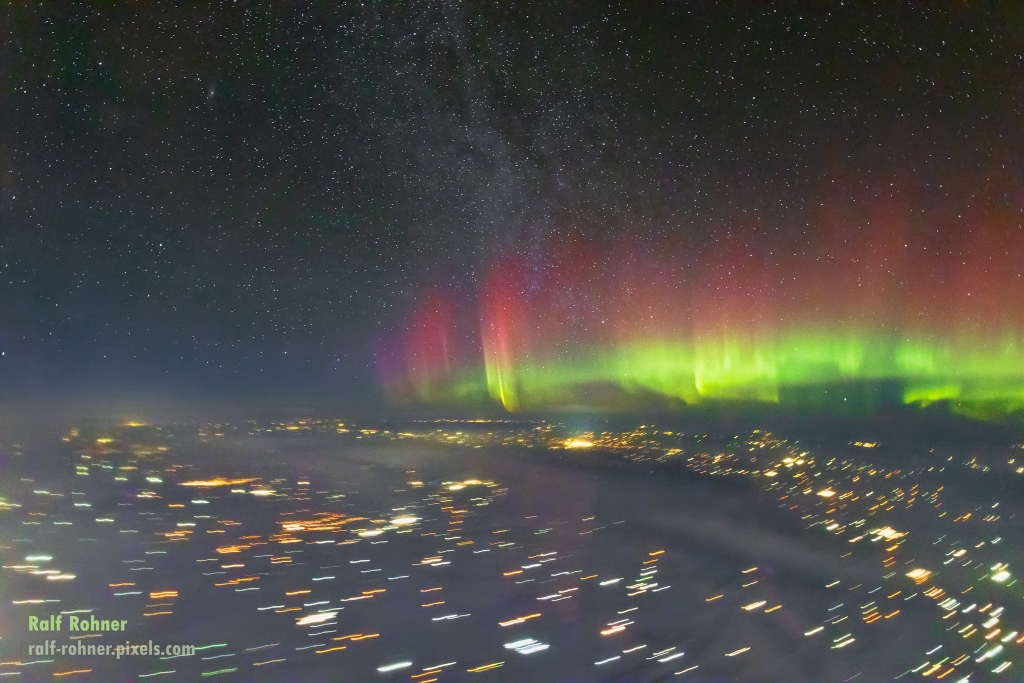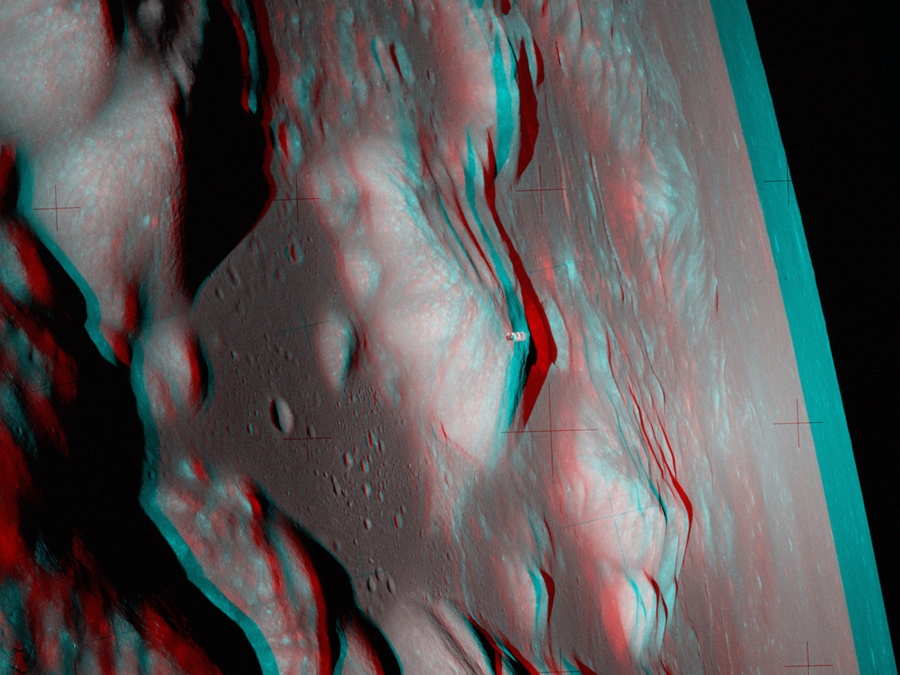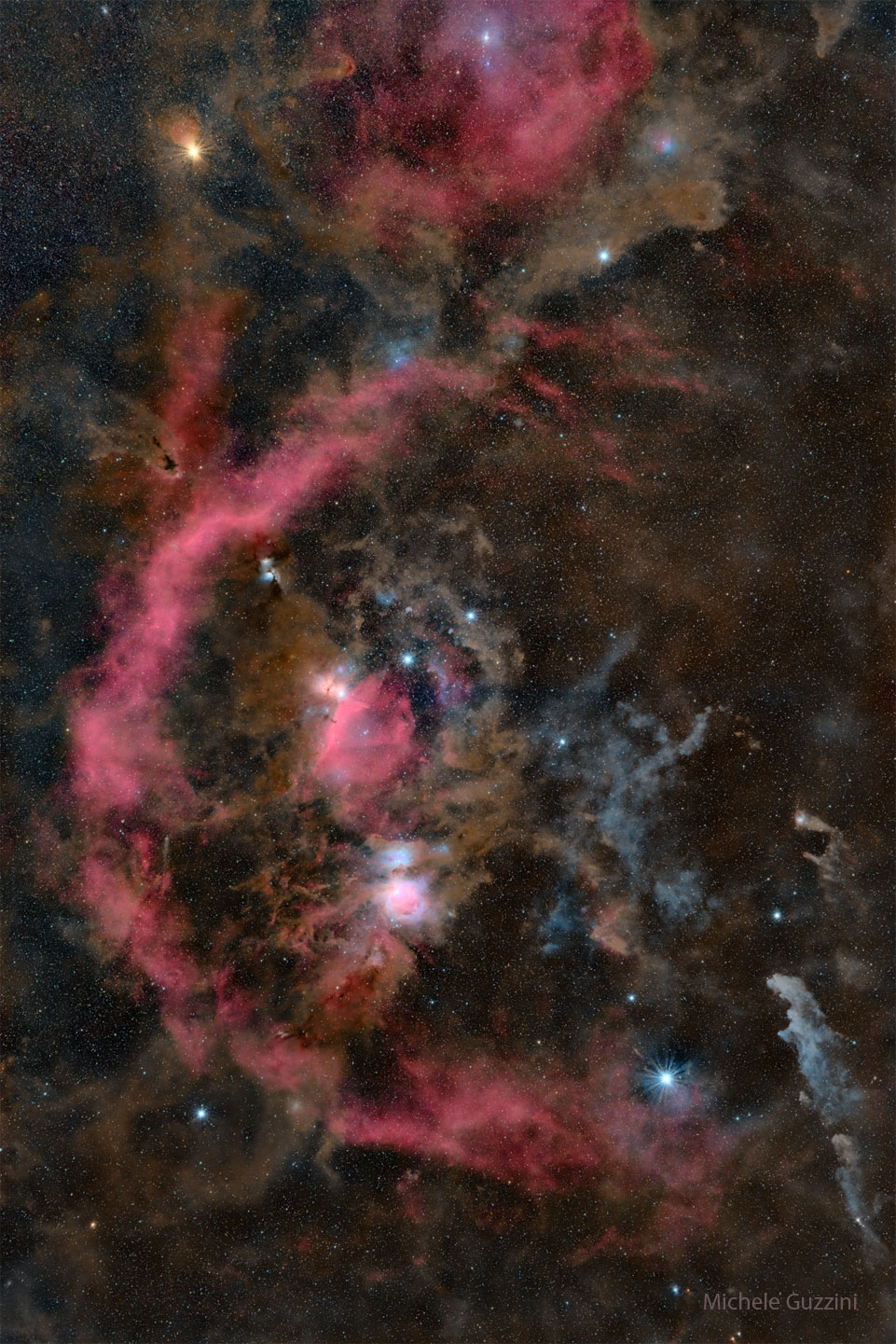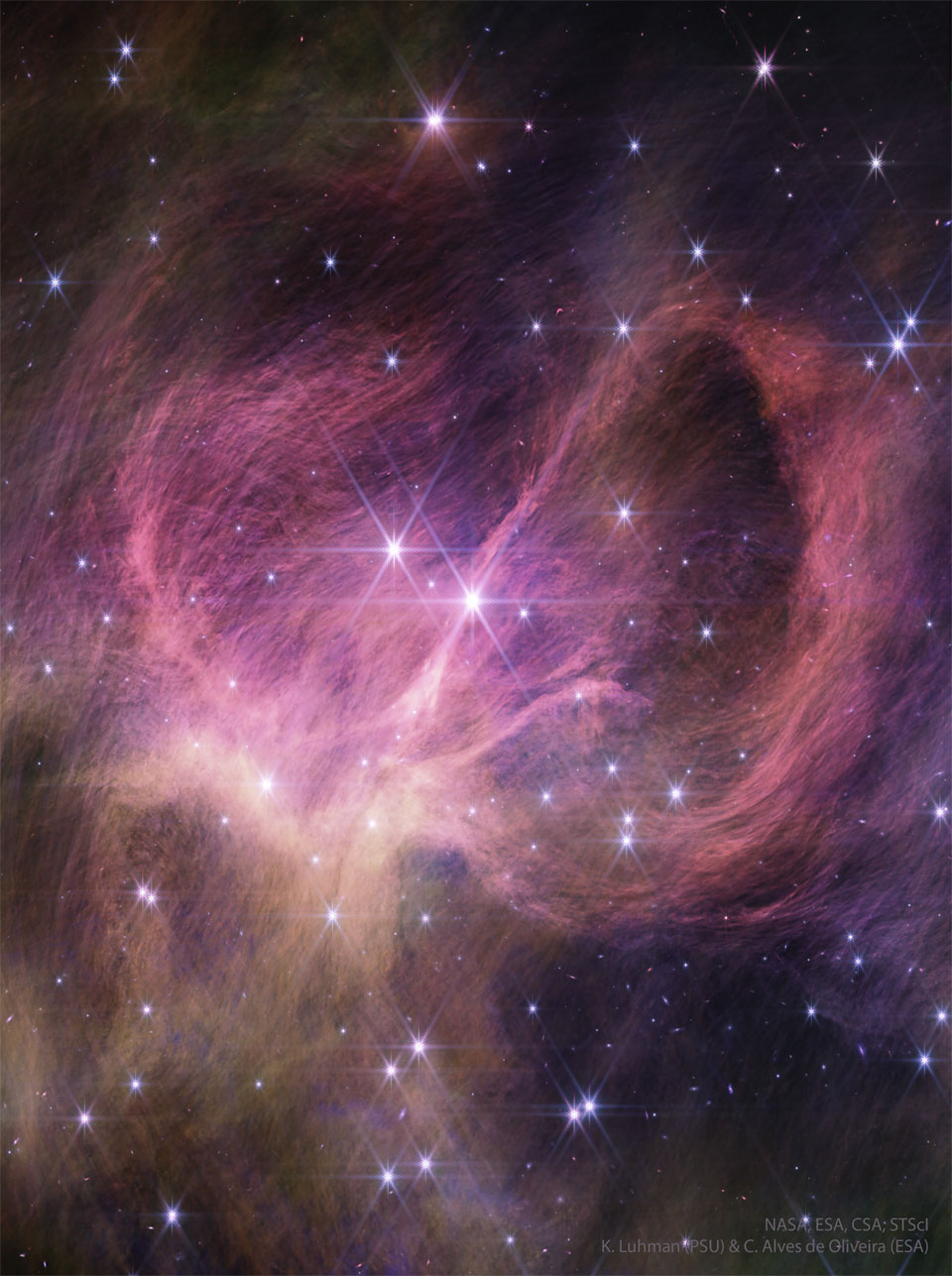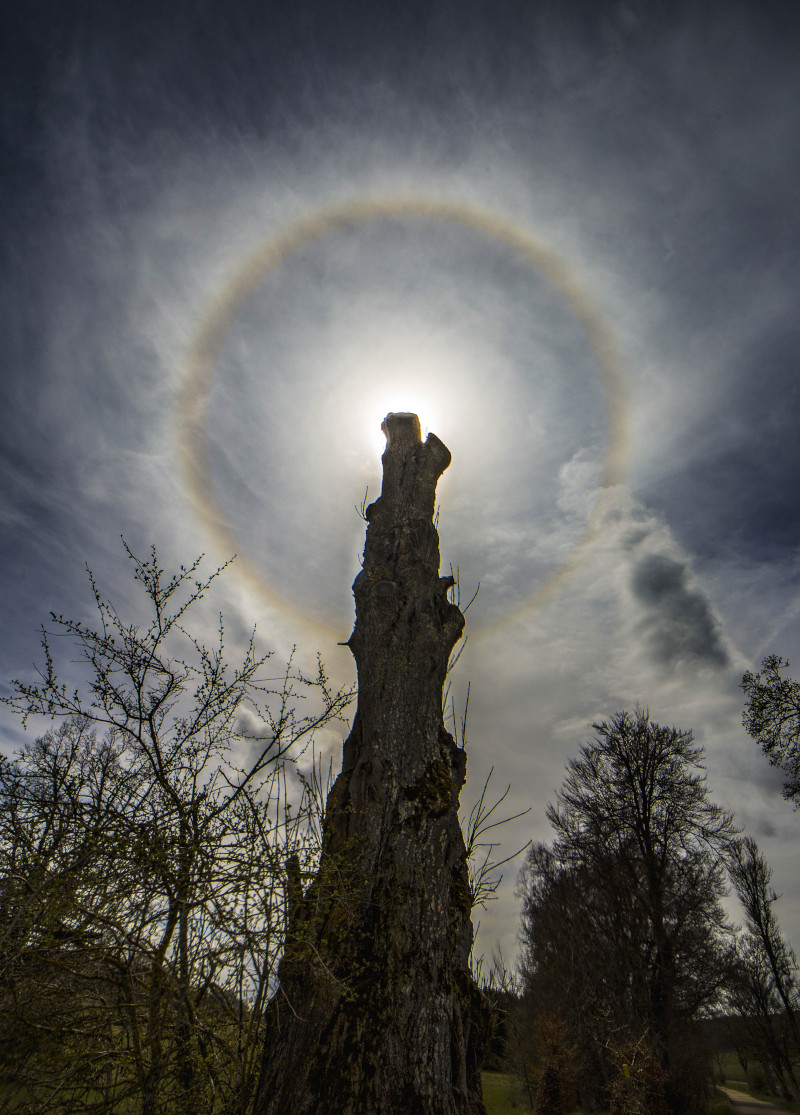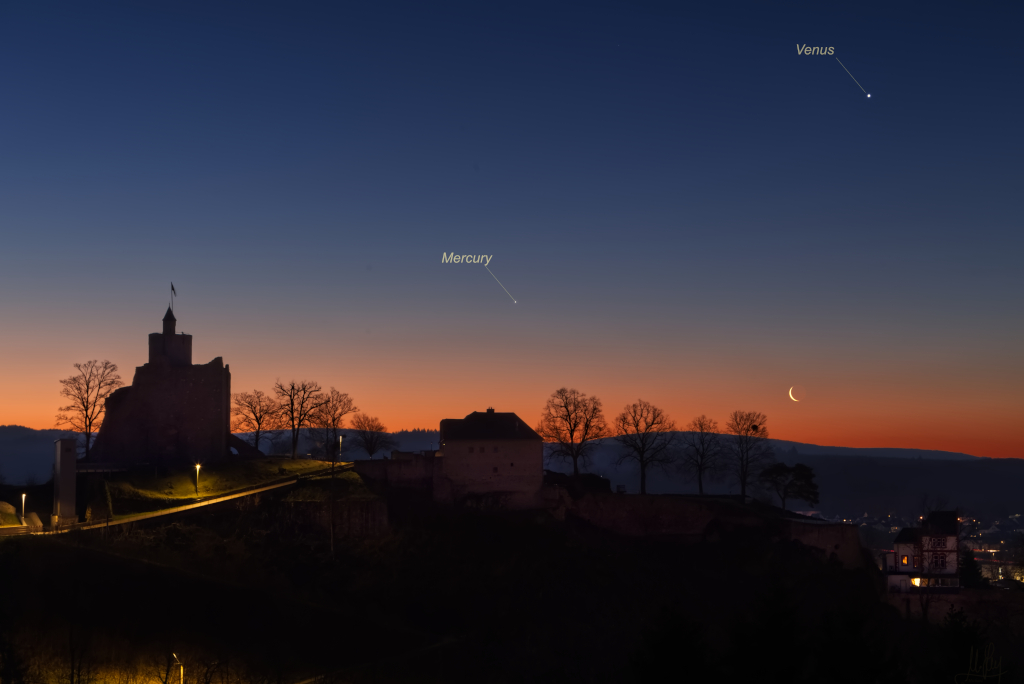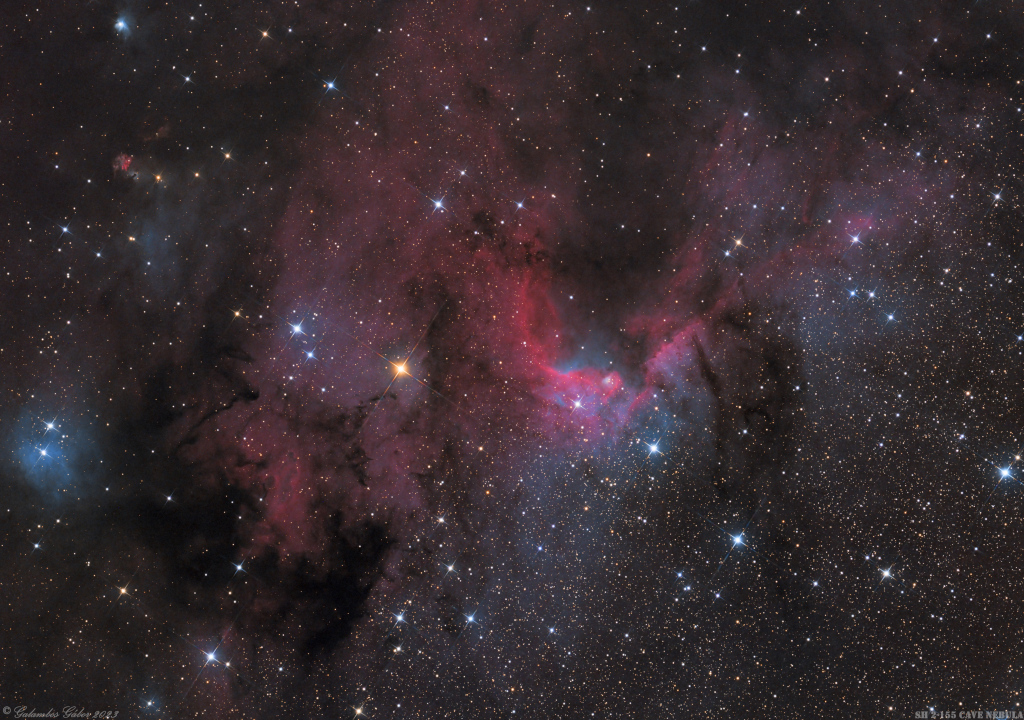
Nombre total de pages vues
31/01/2024
LE JARDIN MERVEILLEUX DES EPICES - Le gingembre, une plante médicinale ancienne

ASTRONOMY - Camera Orion Rising
2024 January 31
Image Credit & Copyright: Marcin Ślipko
Explanation: What does Orion rising look like to a camera? During this time of the year, the famous constellation is visible to the southeast just after sunset. From most Earthly locations, Orion's familiar star pattern, highlighted by the three-stars-in-a-row belt stars, rises sideways. An entire section of the night sky that includes Orion was photographed rising above Śnieżka, a mountain on the border between Poland and the Czech Republic. The long duration exposure sequence brings up many faint features including the Orion and Flame Nebulas, both encompassed by the curving Barnard's Loop. The featured wide-angle camera composite also captured night sky icons including the blue Pleiades star cluster at the image top and the red Rosette Nebula to the left of Orion. Famous stars in the frame include Sirius, Betelgeuse, Rigel and Aldebaran. Orion will appear successively higher in the sky at sunset during the coming months.
30/01/2024
ASTRONOMY - SLIM Lands on the Moon
2024 January 30
Image Credit & Copyright: JAXA, Takara Tomy, Sony Co., Doshisha U.
Explanation: New landers are on the Moon. Nearly two weeks ago, Japan's Smart Lander for Investigating Moon (SLIM) released two rovers as it descended, before its main lander touched down itself. The larger of the two rovers can hop like a frog, while the smaller rover is about the size of a baseball and can move after pulling itself apart like a transformer. The main lander, nicknamed Moon Sniper, is seen in the featured image taken by the smaller rover. Inspection of the image shows that Moon Sniper's thrusters are facing up, meaning that the lander is upside down from its descent configuration and on its side from its intended landing configuration. One result is that Moon Sniper's solar panels are not in the expected orientation, so that powering the lander had to be curtailed and adapted. SLIM's lander has already succeeded as a technology demonstration, its main mission, but was not designed to withstand the lunar night -- which starts tomorrow.
29/01/2024
LE JARDIN MERVEILLEUX DES EPICES - La fève de Tonka, l'épice riche en arôme

ASTRONOMY - The Pleiades: Seven Dusty Sisters
2024 January 29
Image Credit & Copyright: Craig Stocks
Explanation: The well-known Pleiades star cluster is slowly destroying part of a passing cloud of gas and dust. The Pleiades is the brightest open cluster of stars on Earth's sky and can be seen from almost any northerly location with the unaided eye. Over the past 100,000 years, a field of gas and dust is moving by chance right through the Pleiades star cluster and is causing a strong reaction between the stars and dust. The passing cloud might be part of the Radcliffe wave, a newly discovered structure of gas and dust connecting several regions of star formation in the nearby part of our Milky Way galaxy. Pressure from the stars' light significantly repels the dust in the surrounding blue reflection nebula, with smaller dust particles being repelled more strongly. A short-term result is that parts of the dust cloud have become filamentary and stratified. The featured deep image incorporates nearly 9 hours of exposure and was captured from Utah Desert Remote Observatory in Utah, USA, last year.
28/01/2024
ASTRONOMY - Pluto in True Color
2024 January 28
Image Credit: NASA, JHU APL, SwRI; Processing: Alex Parker
Explanation: What color is Pluto, really? It took some effort to figure out. Even given all of the images sent back to Earth when the robotic New Horizons spacecraft sped past Pluto in 2015, processing these multi-spectral frames to approximate what the human eye would see was challenging. The result featured here, released three years after the raw data was acquired by New Horizons, is the highest resolution true color image of Pluto ever taken. Visible in the image is the light-colored, heart-shaped, Tombaugh Regio, with the unexpectedly smooth Sputnik Planitia, made of frozen nitrogen, filling its western lobe. New Horizons found the dwarf planet to have a surprisingly complex surface composed of many regions having perceptibly different hues. In total, though, Pluto is mostly brown, with much of its muted color originating from small amounts of surface methane energized by ultraviolet light from the Sun.
27/01/2024
O FUTURO NO PRESENTE - Versatilidade - Carro voador

LE MERVEILLEUX JARDIN DES EPICES - Le curcuma, l'épice qui colore nos assiettes

ASTRONOMY - Full Observatory Moon
2024 January 27
Image Credit & Copyright: Yuri Beletsky (Carnegie Las Campanas Observatory, TWAN)
Explanation: A popular name for January's full moon in the northern hemisphere is the Full Wolf Moon. As the new year's first full moon, it rises over Las Campanas Observatory in this dramatic Earth-and-moonscape. Peering from the foreground like astronomical eyes are the observatory's twin 6.5 meter diameter Magellan telescopes. The snapshot was captured with telephoto lens across rugged terrain in the Chilean Atacama Desert, taken at a distance of about 9 miles from the observatory and about 240,000 miles from the lunar surface. Of course the first full moon of the lunar new year, known to some as the Full Snow Moon, will rise on February 24.
26/01/2024
ASTRONOMY - Epsilon Tauri: Star with Planet
2024 January 26
Image Credit & Copyright: Reg Pratt
Explanation: Epsilon Tauri lies 146 light-years away. A K-type red giant star, epsilon Tau is cooler than the Sun, but with about 13 times the solar radius it has nearly 100 times the solar luminosity. A member of the Hyades open star cluster the giant star is known by the proper name Ain, and along with brighter giant star Aldebaran, forms the eyes of Taurus the Bull. Surrounded by dusty, dark clouds in Taurus, epsilon Tau is also known to have a planet. Discovered by radial velocity measurements in 2006, Epsilon Tauri b is a gas giant planet larger than Jupiter with an orbital period of 1.6 years. And though the exoplanet can't be seen directly, on a dark night its parent star epsilon Tauri is easily visible to the unaided eye.
25/01/2024
O FUTURO NO PRESENTE - Sustentabilidade do Pal-V Liberty Pioneer Edition

LE JARDIN MERVEILLEUX DES EPICES - Le fenouil et ses vertus digestives

ASTRONOMY - Jyväskylä in the Sky
2024 January 25
Image Credit & Copyright: Harri Kiiskinen
Explanation: You might not immediately recognize this street map of a neighborhood in Jyväskylä, Finland, planet Earth. But that's probably because the map was projected into the night sky and captured with an allsky camera on January 16. The temperature recorded on that northern winter night was around minus 20 degrees Celsius. As ice crystals formed in the atmosphere overhead, street lights spilling illumination into the sky above produced visible light pillars, their ethereal appearance due to specular reflections from the fluttering crystals' flat surfaces. Of course, the projected light pillars trace a map of the brightly lit local streets, though reversed right to left in the upward looking camera's view. This light pillar street map was seen to hover for hours in the Jyväskylä night.
24/01/2024
ASTRONOMY - Earth and Moon from Beyond
2024 January 24
Image Credit: NASA, Artemis I; Processing: Andy Saunders
Explanation: What do the Earth and Moon look like from beyond the Moon? Although frequently photographed together, the familiar duo was captured with this unusual perspective in late 2022 by the robotic Orion spacecraft of NASA's Artemis I mission as it looped around Earth's most massive satellite and looked back toward its home world. Since our Earth is about four times the diameter of the Moon, the satellite’s seemingly large size was caused by the capsule being closer to the smaller body. Artemis II, the next launch in NASA’s Artemis series, is currently scheduled to take people around the Moon in 2025, while Artemis III is planned to return humans to lunar surface in late 2026. Last week, JAXA's robotic SLIM spacecraft, launched from Japan, landed on the Moon and released two hopping rovers.
23/01/2024
O FUTURO NO PRESENTE - Características do carro voador

LE JARDIN MERVEILLEUX DES EPICES - La coriandre, l’épice des pharaons

ASTRONOMY - Deep Nebulas: From Seagull to California
2024 January 23
Image Credit & Copyright: Alistair Symon
Explanation: How well do you know the night sky? OK, but how well can you identify famous sky objects in a very deep image? Either way, here is a test: see if you can find some well-known night-sky icons in a deep image filled with faint nebulosity. This image contains the Pleiades star cluster, Barnard's Loop, Horsehead Nebula, Orion Nebula, Rosette Nebula, Cone Nebula, Rigel, Jellyfish Nebula, Monkey Head Nebula, Flaming Star Nebula, Tadpole Nebula, Aldebaran, Simeis 147, Seagull Nebula and the California Nebula. To find their real locations, here is an annotated image version. The reason this task might be difficult is similar to the reason it is initially hard to identify familiar constellations in a very dark sky: the tapestry of our night sky has an extremely deep hidden complexity. The featured composite reveals some of this complexity in a mosaic of 28 images taken over 800 hours from dark skies over Arizona, USA.
22/01/2024
ASTRONOMY - Shadows of Mountain and Moon
2024 January 22
Image Credit & Copyright: Enzo Massa Micon
Explanation: Can the Moon and a mountain really cast similar shadows? Yes, but the division between light and dark does not have to be aligned. Pictured, a quarter moon was captured above the mountain Grivola in Italy in early October of 2022. The Sun is to the right of the featured picturesque landscape, illuminating the right side of the Moon in a similar way that it illuminates the right side of the mountain. This lunar phase is called "quarter" because the lit fraction visible from Earth is one quarter of the entire lunar surface. Digital post-processing of this single exposure gave both gigantic objects more prominence. Capturing the terminator of this quarter moon in close alignment with nearly vertical mountain ridge required careful timing because the Earth rotates once a day.
21/01/2024
BIOMIMETISME - Innovations inspirées par la Nature - La soie super-résistante des araignées

LE JARDIN MERVEILLEUX DES EPICES - Le cumin une épice forte en goût

ASTRONOMY - The Upper Michigan Blizzard of 1938
Image Credit: Bill Brinkman; Courtesy: Paula Rocco
Explanation: Yes, but can your blizzard do this? In the Upper Peninsula of Michigan's Storm of the Century in 1938, some snow drifts reached the level of utility poles. Nearly a meter of new and unexpected snow fell over two days in a storm that started 86 years ago this week. As snow fell and gale-force winds piled snow to surreal heights, many roads became not only impassable but unplowable; people became stranded, cars, school buses and a train became mired, and even a dangerous fire raged. Two people were killed and some students were forced to spend several consecutive days at school. The featured image was taken by a local resident soon after the storm. Although all of this snow eventually melted, repeated snow storms like this help build lasting glaciers in snowy regions of our planet Earth.
20/01/2024
ASTRONOMY - Falcon Heavy Boostback Burn
2024 January 20
Image Credit & Copyright: Dennis Huff
Explanation: The December 28 night launch of a Falcon Heavy rocket from Kennedy Space Center in Florida marked the fifth launch for the rocket's reusable side boosters. About 2 minutes 20 seconds into the flight, the two side boosters separated from the rocket's core stage. Starting just after booster separation, this three minute long exposure captures the pair's remarkable boostback burns, maneuvers executed prior to their return to landing zones on planet Earth. While no attempt was made to recover the Falcon Heavy's core stage, both side boosters landed successfully and can be flown again. The four previous flights for these side boosters included last October's launch of NASA's asteroid-bound Psyche mission.
19/01/2024
O FUTURO NO PRESENTE - O carro voador - Pal-V Liberty Pioneer Edition
BIOMIMETISME - Innovations inspirées par la Nature - La cape d'invisibilité des seiches inspire les roboticiens

ASTRONOMY - Jupiter over 2 Hours and 30 Minutes
2024 January 19
Image Credit & License: Aurélien Genin
Explanation: Jupiter, our Solar System's ruling gas giant, is also the fastest spinning planet, rotating once in less than 10 hours. The gas giant doesn't rotate like a solid body though. A day on Jupiter is about 9 hours and 56 minutes long at the poles, decreasing to 9 hours and 50 minutes near the equator. The giant planet's fast rotation creates strong jet streams, separating its clouds into planet girdling bands of dark belts and bright zones. You can easily follow Jupiter's rapid rotation in this sharp sequence of images from the night of January 15, all taken with a camera and small telescope outside of Paris, France. Located just south of the equator, the giant planet's giant storm system, also known as the Great Red Spot, can be seen moving left to right with the planet's rotation. From lower left to upper right, the sequence spans about 2 hours and 30 minutes.
18/01/2024
ASTRONOMY - Northern Lights from the Stratosphere
2024 January 18
Image Credit & Copyright: Ralf Rohner
Explanation: Northern lights shine in this night skyview from planet Earth's stratosphere, captured on January 15. The single, 5 second exposure was made with a hand-held camera on board an aircraft above Winnipeg, Canada. During the exposure, terrestrial lights below leave colorful trails along the direction of motion of the speeding aircraft. Above the more distant horizon, energetic particles accelerated along Earth's magnetic field at the planet's polar regions excite atomic oxygen to create the shimmering display of Aurora Borealis. The aurora's characteristic greenish hue is generated at altitudes of 100-300 kilometers and red at even higher altitudes and lower atmospheric densities. The luminous glow of faint stars along the plane of our Milky Way galaxy arcs through the night, while the Andromeda galaxy extends this northern skyview to extragalactic space. A diffuse hint of Andromeda, the closest large spiral to the Milky Way, can just be seen to the upper left.
17/01/2024
LE JARDIN MERVEILLEUX DES EPICES - Le carvi - l'épice efficace pour la digestion

ASTRONOMY - America and the Sea of Serenity
Image Credit & Copyright: Gene Cernan, Apollo 17, NASA; Anaglyph by Patrick Vantuyne
Explanation: Get out your red/blue glasses and check out this stereo view of another world. The scene was recorded by Apollo 17 mission commander Eugene Cernan on December 11, 1972, one orbit before descending to land on the Moon. The stereo anaglyph was assembled from two photographs (AS17-147-22465, AS17-147-22466) captured from his vantage point on board the Lunar Module Challenger as he and Dr. Harrison Schmitt flew over Apollo 17's landing site in the Taurus-Littrow Valley. The broad, sunlit face of the mountain dubbed South Massif rises near the center of the frame, above the dark floor of Taurus-Littrow to its left. Piloted by Ron Evans, the Command Module America is visible in orbit in the foreground against the South Massif's peak. Beyond the mountains, toward the lunar limb, lies the Moon's Mare Serenitatis. Four astronauts will venture around the Moon and back again on the Artemis II mission, scheduled for launch no earlier than September 2025.
16/01/2024
O FUTURO NO PRESENTE - O carro voador - Pal-V Liberty Pioneer Edition

ASTRONOMY - The Orion You Can Almost See
2024 January 16
Image Credit & Copyright: Michele Guzzini
Explanation: Do you recognize this constellation? Although it is one of the most recognizable star groupings on the sky, this is a more full Orion than you can see -- an Orion only revealed with long exposure digital camera imaging and post- processing. Here the cool red giant Betelgeuse takes on a strong orange tint as the brightest star on the upper left. Orion's hot blue stars are numerous, with supergiant Rigel balancing Betelgeuse on the lower right, and Bellatrix at the upper right. Lined up in Orion's belt are three stars all about 1,500 light-years away, born from the constellation's well-studied interstellar clouds. Just below Orion's belt is a bright but fuzzy patch that might also look familiar -- the stellar nursery known as Orion's Nebula. Finally, just barely visible to the unaided eye but quite striking here is Barnard's Loop -- a huge gaseous emission nebula surrounding Orion's Belt and Nebula discovered over 100 years ago by the pioneering Orion photographer E. E. Barnard.
15/01/2024
LE JARDIN MERVEILLEUX DES EPICES - La cardamome - épice à consommer avec modération

ASTRONOMY - Star Cluster IC 348 from Webb
2024 January 15
Image Credit: NASA, ESA, CSA, STScI, and K. Luhman (Penn State U.) and C. Alves de Oliveira (ESA)
Explanation: Sometimes, it's the stars that are the hardest to see that are the most interesting. IC 348 is a young star cluster that illuminates surrounding filamentary dust. The stringy and winding dust appears pink in this recently released infrared image from the Webb Space Telescope. In visible light, this dust reflects mostly blue light, giving the surrounding material the familiar blue hue of a reflection nebula. Besides bright stars, several cool objects have been located in IC 348, visible because they glow brighter in infrared light. These objects are hypothesized to be low mass brown dwarfs. Evidence for this includes the detection of an unidentified atmospheric chemical, likely a hydrocarbon, seen previously in the atmosphere of Saturn. These objects appear to have masses slightly greater than known planets, only a few times greater than Jupiter. Together, these indicate that this young star cluster contains something noteworthy -- young planet-mass brown dwarfs that float free, not orbiting any other star.
14/01/2024
ASTRONOMY - Dragon Aurora over Iceland
2024 January 14
Image Credit & Copyright: Jingyi Zhang & Wang Zheng
Explanation: Have you ever seen a dragon in the sky? Although real flying dragons don't exist, a huge dragon-shaped aurora developed in the sky over Iceland in 2019. The aurora was caused by a hole in the Sun's corona that expelled charged particles into a solar wind that followed a changing interplanetary magnetic field to Earth's magnetosphere. As some of those particles then struck Earth's atmosphere, they excited atoms which subsequently emitted light: aurora. This iconic display was so enthralling that the photographer's mother ran out to see it and was captured in the foreground. Our active Sun continues to show an unusually high number of prominences, filaments, sunspots, and large active regions as solar maximum approaches in 2025.
13/01/2024
BIOMIMETISME - Innovations inspirées par la Nature - De la peau de requin sur des avions

LE JARDIN MERVEILLEUX DES EPICES - La cannelle, l’une des plus anciennes épices

ASTRONOMY - Circling the Sun
Image Credit & Copyright: Radoslav Zboran
Explanation: Earth's orbit around the Sun is not a circle, it's an ellipse. The point along its elliptical orbit where our fair planet is closest to the Sun is called perihelion. This year, perihelion was on January 2 at 01:00 UTC, with the Earth about 3 million miles closer to the Sun than it was at aphelion (last July 6), the farthest point in its elliptical orbit. Of course, distance from the Sun doesn't determine the seasons, and it doesn't the determine size of Sun halos. Easier to see with the Sun hidden behind a tall tree trunk, this beautiful ice halo forms a 22 degree-wide circle around the Sun, recorded while strolling through the countryside near Heroldstatt, Germany. The Sun halo's 22 degree angular diameter is determined by the six-sided geometry of water ice crystals drifting high in planet Earth's atmosphere.
12/01/2024
ASTRONOMY - Good Morning Moon
2024 January 12
Image Credit & Copyright: Michael Luy, Trier Observatory, TWAN
Explanation: Yesterday, the Moon was New. But on January 9, early morning risers around planet Earth were treated to the sight of an old Moon, low in the east as the sky grew bright before dawn. Above the city of Saarburg in Rhineland-Palatinate, western Germany, this simple snapshot found the waning Moon's sunlit crescent just before sunrise. But also never wandering far from the Sun in Earth's sky, inner planets Venus and Mercury shared the cold morning skyview. In the foreground are the historic city's tower and castle with ruins from the 10th century.
11/01/2024
BIOMIMETISME - Innovations inspirées par la Nature - Des éoliennes imaginées à partir des nageoires des baleines

O FUTURO NO PRESENTE - O carro voador chegou (2)

ASTRONOMY - Quadrantids of the North
2024 January 11
Image Credit & Copyright: 염범석 Yeom Beom-seok
Explanation: Named for a forgotten constellation, the Quadrantid Meteor Shower puts on an annual show for planet Earth's northern hemisphere skygazers. The shower's radiant on the sky lies within the old, astronomically obsolete constellation Quadrans Muralis. That location is not far from the Big Dipper asterism, known to some as the Plough, at the boundaries of the modern constellations Bootes and Draco. In fact the Big Dipper "handle" stars are near the upper right corner in this frame, with the meteor shower radiant just below. North star Polaris is toward the top left. Pointing back toward the radiant, Quadrantid meteors streak through the night in this skyscape from Jangsu, South Korea. The composite image was recorded in the hours around the shower's peak on January 4, 2024. A likely source of the dust stream that produces Quadrantid meteors was identified in 2003 as an asteroid.
10/01/2024
ASTRONOMY - The Light, the Dark, and the Dusty
2024 January 10
Image Credit & Copyright: Gábor Galambos
Explanation: This colorful skyscape spans about three full moons across nebula rich starfields along the plane of our Milky Way Galaxy toward the royal northern constellation Cepheus. Near the edge of the region's massive molecular cloud some 2,400 light-years away, bright reddish emission region Sharpless (Sh)2-155 is at the center of the frame, also known as the Cave Nebula. About 10 light-years across the cosmic cave's bright walls of gas are ionized by ultraviolet light from the hot young stars around it. Dusty bluish reflection nebulae, like vdB 155 at the left, and dense obscuring clouds of dust also abound on the interstellar canvas. Astronomical explorations have revealed other dramatic signs of star formation, including the bright reddish fleck of Herbig-Haro (HH) 168. At the upper left in the frame, the Herbig-Haro object emission is generated by energetic jets from a newborn star.
09/01/2024
O FUTURO NO PRESENTE - O carro voador chegou (1)

LE JARDIN MERVEILLEUX DES EPICES - Le macis, cousin de la noix de muscade

ASTRONOMY - Orion and the Ocean of Storms
2025 December 13 Orion and the Ocean of Storms Image Credit: NASA , Artemis 1 Explanation: On December 5, 2022, a camera on board the u...

-
2022 September 26 All the Water on Planet Earth Illustration Credit: Jack Cook, Adam Nieman, Woods Hole Oceanographic Institution ; Data ...
-
2025 May 11 The Surface of Venus from Venera 14 Image Credit: Soviet Planetary Exploration Program , Venera 14 ; Processing & Copyri...






